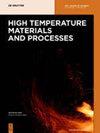Effect of high temperature tempering on the phase composition and structure of steelmaking slag
IF 1.5
4区 材料科学
Q4 MATERIALS SCIENCE, MULTIDISCIPLINARY
引用次数: 0
Abstract
Abstract Blast furnace slag and steelmaking slag, as the main accessory products of iron and steel smelting, are piled up in large quantities due to their huge output, high treatment difficulty and low comprehensive utilization rate, which has a serious impact on the land and environment. In order to improve the comprehensive utilization of steelmaking slag, low basicity blast furnace slag was added to the existing steel slag for quenching and tempering. The influence of basicity on the chemical composition and phase precipitation of mixed slag was analyzed. In the research process, the phase composition and morphology of blast furnace slag and steel slag of Baotou Steel were analyzed using FactSage7.1 thermodynamic calculation software, ZEISS high-resolution scanning electron microscope (SEM), modern fast high-resolution Bruker energy dispersive spectrometer and AMICS-Mining automatic mineral analysis software. The results show that the mineral phase composition of blast furnace slag is mainly calcium aluminum yellow feldspar and that of steelmaking slag is mainly dicalcium silicate(C2S), magnesium-iron phase solid solution, rose pyroxene and calcium iron aluminate. When the basicity of the mixed slag is 2.0, it can effectively inhibit the formation of non-cementitious mineral anorthite and promote the formation of better cementitious mineral C2S. At the same time, it is found that the melting temperature of mixed slag decreases with the increase in Al2O3 content.高温回火对炼钢渣相组成和组织的影响
摘要高炉矿渣和钢渣作为钢铁冶炼的主要副产品,由于产量大、处理难度大、综合利用率低,堆积量大,对土地和环境造成严重影响。为了提高钢渣的综合利用率,在现有钢渣中加入低碱度高炉矿渣进行调质处理。分析了碱度对混合渣化学成分和相沉淀的影响。在研究过程中,使用FactSage7.1热力学计算软件、蔡司高分辨率扫描电子显微镜(SEM)、现代快速高分辨率Bruker能谱仪和AMICS Mining自动矿物分析软件对包钢高炉矿渣和钢渣的相组成和形态进行了分析。结果表明,高炉矿渣的矿物相组成主要为钙铝黄长石,钢渣的矿物相成分主要为硅酸二钙(C2S)、镁铁相固溶体、玫瑰辉石和铝酸钙铁。当混合矿渣的碱度为2.0时,可以有效抑制非胶结矿物钙长石的形成,促进较好胶结矿物C2S的形成。同时发现,随着Al2O3含量的增加,混合渣的熔化温度降低。
本文章由计算机程序翻译,如有差异,请以英文原文为准。
求助全文
约1分钟内获得全文
求助全文
来源期刊

High Temperature Materials and Processes
工程技术-材料科学:综合
CiteScore
2.50
自引率
0.00%
发文量
42
审稿时长
3.9 months
期刊介绍:
High Temperature Materials and Processes offers an international publication forum for new ideas, insights and results related to high-temperature materials and processes in science and technology. The journal publishes original research papers and short communications addressing topics at the forefront of high-temperature materials research including processing of various materials at high temperatures. Occasionally, reviews of a specific topic are included. The journal also publishes special issues featuring ongoing research programs as well as symposia of high-temperature materials and processes, and other related research activities.
Emphasis is placed on the multi-disciplinary nature of high-temperature materials and processes for various materials in a variety of states. Such a nature of the journal will help readers who wish to become acquainted with related subjects by obtaining information of various aspects of high-temperature materials research. The increasing spread of information on these subjects will also help to shed light on relevant topics of high-temperature materials and processes outside of readers’ own core specialties.
 求助内容:
求助内容: 应助结果提醒方式:
应助结果提醒方式:


